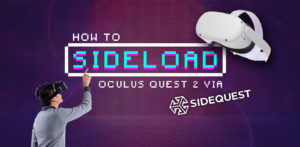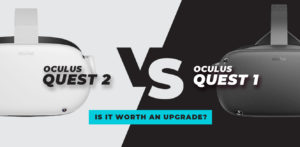For a long time, VR full-body tracking (FBT) has been prohibitively expensive, with solutions like the Vive trackers and Steam’s Lighthouses being the mainstays. More affordable alternatives have been introduced by the VR community recently, though, so FBT is now accessible to more people. From do-it-yourself methods to cutting-edge tech, this article will cover all the cheapest ways to get full-body tracking in virtual reality. Let’s get into it!
Things to Note Before Buying
Before exploring affordable full-body tracking solutions for virtual reality, it is important to consider certain factors. Currently, it is critical to note that full-body tracking is supported by only a small percentage of virtual reality games and apps. Among the most popular platforms for full-body tracking, VRChat stands out.
Additionally, please take into consideration that standalone full-body tracking is not currently supported for users of the Meta Quest 2 or 3 headsets. The Quest needs to be linked to a VR-ready PC using Oculus Link or Air Link to activate this feature. For this reason, you must guarantee that your virtual reality system comprises a compatible personal computer for maximum performance.
Buyers can better align their expectations with the current state of virtual reality software compatibility and meta quest 2 PC hardware requirements by being aware of these important considerations and making informed decisions about investing in full-body tracking solutions.
AprilTagsVR
An interesting and reasonably priced full-body tracking (FBT) option for virtual reality (VR) fans has emerged: AprilTagsVR, created by Reddit user u/juice4. To those looking for an affordable alternative, AprilTagsVR’s methodology is simple enough to understand and implement.
To set up AprilTagsVR, users need a few basic components:
 Webcam Placement:
Webcam Placement:
First things first, set up a webcam in your virtual reality (VR) play area. For motion tracking, this is the principal sensor.
Printed QR Codes:
Create paper QR codes to use as markers at specific locations on your body; these will serve as a kind of printed QR code. Attaching these markers to your knees, elbows, and hips will allow for thorough tracking.
Low Price and Easy Do-It-Yourself Appeal:
AprilTagsVR’s low price is one of its most notable features. An appealing option for individuals on a tight budget, all you need is a webcam and a printer. Users are allowed to create their tracking system, which adds to the solution’s appeal.
Having said that, there are a few things to keep in mind when using AprilTagsVR:
Depth Limitations:
Because it uses a webcam exclusively, AprilTagsVR might not be able to capture 3D depth very well. On rare occasions, this might lead to inconsistencies in tracking movements.
Potential Lag:
Because of their physical constraints, regular webcams may cause some latency when used for live video conferencing. When using full-body tracking, users should anticipate experiencing some latency.
To summarize, AprilTagsVR offers a cost-effective and user-friendly solution for individuals interested in investigating full-body tracking in virtual reality. Users looking for an affordable FBT solution may be interested in this option due to its simplicity and low price, even though it may not provide the same level of accuracy as more costly alternatives.
MediaPipe
Another one of u/juice4’s creations, MediaPipe, has recently emerged as a novel approach to full-body tracking. Similar to AprilTagsVR, MediaPipe uses a webcam as its only tracking mechanism, to give users an easy and cheap way to accomplish full-body tracking in VR.
The setup process for MediaPipe is characterized by its simplicity:
Use of the Webcam:
A webcam is the backbone of the MediaPipe system, which gets rid of the need to buy extra hardware. Users looking for a simple tracking solution will find it appealing because of this.
Low Setup Effort:
One thing that sets MediaPipe apart is how easy it is to set up. Users can anticipate a simple and fast setup process, cutting down on the amount of time and energy needed to launch the system.
Although these benefits are worth considering, there are a few potential downsides to MediaPipe:
Novelty and Instability:
MediaPipe, being a relatively new addition to the full-body tracking landscape, may still be in the process of refining its stability. Problems with setup or inconsistent system performance are possible for users.
User Experience Variability:
MediaPipe, like any technology, can have varying impacts on different users. Although some may discover it to be an easy and efficient solution, others might run into problems when calibrating, which could affect the tracking system’s overall stability.
Finally, for those in search of an affordable and easy-to-use full-body tracking solution, MediaPipe presents a fascinating alternative. Its performance may differ, and it may need additional refinement to attain broad user satisfaction, due to its novelty and possible stability issues. Users should go into it with that mindset.
Kinect2VR
Taking cues from the now-defunct Kinect devices from the early 2010s, Kinect2VR presents an intriguing method for full-body tracking in VR. Kinect stands out from webcam-based alternatives and improves tracking capabilities overall thanks to its incorporation of depth sensors.
Setting up Kinect2VR is a streamlined process:
Acquisition of Kinect Devices:
Users must acquire Kinect devices, which might include looking into used markets or finding new uses for old Kinect gear.
Advantage of Depth Sensors:
Kinect2VR has depth sensors, which allow for more precise and thorough tracking than webcam-based solutions. A more engaging full-body tracking experience is enhanced by this feature.
Support from the Community:
Kinect2VR has a strong and active community that helps keep the software running well. This guarantees that there will be continuous improvement, updates, and possible answers to problems that users might face when setting it up or using it.
It is critical to remember that Kinect2VR does have some limitations, though:
Occasional Lag:
Although Kinect2VR’s depth tracking is superior to webcams, users may occasionally encounter noticeable lag. Because of this, the full-body tracking system’s responsiveness in real-time may suffer.
Device Availability:
Some users may find it challenging to obtain Kinect devices due to their discontinuation. People may have to try a few different avenues to get their hands on Kinects since their availability might fluctuate.
Kinect2VR offers an impressive full body tracking solution, improving tracking accuracy by utilizing depth sensors. When thinking about this option for their virtual reality setups, users should keep in mind the possibility of lag and the availability of Kinect devices. However, the active community support guarantees that there will be ongoing improvements.
Driver4VR
One standout full-body tracking solution is Driver4VR, which combines multiple tracking options into one flexible and reasonably priced package. Created with a wide variety of users in mind, this software is compatible with a wide range of tracking devices, making it a great option for those looking for a flexible virtual reality experience without breaking the bank.
Driver4VR’s main features and setup process are detailed below:
Extensive Tracking Options:
One of the best things about Driver4VR is the wide variety of tracking options it supports. You can use it with a Kinect, a webcam, printed trackers (like AprilTags), or even a PlayStation Move controller. Users can select the tracking hardware that aligns with their personal preferences and budget thanks to this diversity.
Active Development:
The developers at Driver4VR are always working on new features and improving the app so that users can enjoy all the newest improvements. Because the developer is dedicated to making the software better, it works better and is easier to use.
Ease of Setup:
When it comes to setting up Driver4VR, users can anticipate a straightforward and fast process. With full body tracking available in VRChat and other compatible apps, users can have the software up and running in less than 10 minutes.
Users of Driver4VR should be mindful of the following concerns, notwithstanding the app’s merits:
Problems May Arise Due to Individual Configurations:
This is typical of software in its early phases of development, and users may experience some problems as a result. There may be times when you need to troubleshoot the software, even though it is constantly getting better.
Overall, with its adaptability, active development, and user-friendly setup, Driver4VR stands out as a top-notch full-body tracking solution. Although there might be a few hiccups for users with certain setups, Driver4VR is a great option for VR enthusiasts on a budget thanks to its extensive tracking options and overall functionality.
SlimeVR
As an alternative to the more conventional and costly options, SlimeVR offers a full-body tracking solution that is both promising and affordable. The goal of the American startup SlimeVR is to offer users affordable, high-quality tracking, so it’s a good option for people who want to improve their virtual reality experiences but don’t want to break the bank.
Here’s an in-depth look at SlimeVR’s features and functionality:
Innovative Tracking:
By integrating open-source software with open-hardware sensors, SlimeVR employs a novel strategy for full-body tracking. By combining the two, users can accomplish full-body tracking without relying on third-party sensors, cameras, or base stations.
Comfortable and Lightweight:
SlimeVR trackers are made to be completely self-contained, lightweight, and easy to wear. By utilizing top-notch inertial measurement unit (IMU) sensors and a Wi-Fi connection to the PC, SlimeVR offers users a hassle-free wireless tracking experience, doing away with the need for bulky wires.
Affordability:
One of the best things about SlimeVR is how cheap it is. For virtual reality fans on a tighter budget, the startup’s preorder bundles of five trackers are great value. The bundles offer a budget-friendly way to get high-quality full-body tracking.
Wide-Ranging Platform Compatibility:
SlimeVR is compatible with a wide range of popular virtual reality software, such as PC games, NeosVR, VRChat, Blade & Sorcery, and many more. Users can effortlessly incorporate SlimeVR into a variety of virtual reality applications and games thanks to its extensive compatibility.
A few things related to SlimeVR should be kept in mind:
Preorder Status:
SlimeVR is now available for preorder according to the information provided. Shipping is expected to start on July 31, 2023. Customers should be aware that there may be delays and make sure they are okay with the preorder status before buying.
Development Progress:
While SlimeVR is an interesting and inexpensive option, it might not have the same high-quality feel as more well-known trackers like Tundra or Shiftall, according to development progress. Users ought to establish reasonable expectations by their individual preferences and requirements.
Those looking for affordable full-body tracking in VR will find SlimeVR to be an innovative and cost-effective option. For those on a tight budget who want to upgrade their virtual reality experiences, this is a great option thanks to its wireless design, low price, and compatibility with all the major platforms.
Honorable Mentions in Budget-Friendly Full-Body Tracking
We have already discussed several affordable full-body tracking solutions, but there are a few more that deserve mention as well. These solutions all have their own set of benefits and features.
Tundra Trackers:
Tundra Labs is well-known as a go-to source for third-party VR trackers in the industry. Tundra Trackers include a universal dongle for easy and practical use, and their hardware is known for being both lightweight and accurate. While keeping the same battery life and accuracy as the Vive 3.0 trackers, the business boasts a 30% weight reduction.
HaritoraX 1.1:
The HaritoraX, created by the Japanese virtual reality technology firm Shiftall, offers a fresh perspective with its five-point full-body tracking system, allowing for eight-point rotation. One feature that sets HaritoraX apart is its eight-point rotation capability, which enables the detection of movement and limb rotation simultaneously. Thanks to its half-bodysuit design, the system doesn’t require any supplementary gear. Unfortunately, the HaritoraX is out of stock at the moment, but it could be back in the future as an affordable option with more advanced tracking capabilities.
From well-known trackers to cutting-edge alternatives, these honorable mentions cover it all. When deciding which VR headset is ideal for your setup, consider your unique tracking requirements, compatibility needs, and budget constraints.
![]()
Conclusion: Navigating the Budget-Friendly Full-Body Tracking Landscape
There is now a plethora of affordable options for full-body tracking in virtual reality, thanks to the surge in demand. Users have a lot of options to choose from. Everyone has different tastes, budgets, and levels of technical knowledge, so it’s important to think about all of these factors when choosing a tracking method.
For those interested in trying out webcam-based tracking, two accessible DIY solutions are AprilTagsVR and MediaPipe. Although these options are affordable, there may be some trade-offs with depth accuracy, and stability.
For individuals looking for a throwback method that still gets the job done, Kinect2VR brings back the original Kinect by enhancing tracking with depth sensors. The robust tracking experience is enhanced by the active community support, which is noticeable despite the occasional lag.
With its affordable bundle of tracking options, Driver4VR stands out as a complete software solution. Users who are up for tackling possible early development hurdles will find it appealing due to its adaptability, simplicity of setup, and continuous development.
When it comes to third-party trackers, Tundra Trackers were the first to market with their universal dongle and lightweight, accurate hardware. Innovative eight-point rotation capabilities are available in the HaritoraX 1.1, and Driver4VR supports a wide variety of tracking devices.
Although SlimeVR seems like a cool and affordable option, being a pre-order means customers must wait for delivery dates, which could be a hassle.
Finally, when looking for a cheap full-body tracking solution, it’s important to consider how important tracking accuracy, usability, and affordability are. Users can make well-informed decisions according to their requirements, improving their virtual experiences without going into debt, as the virtual reality landscape keeps changing. The possibilities offered here lay the way for a more accessible and immersive virtual reality experience, whether you choose a do-it-yourself approach or investigate new technology.
Frequently Asked Questions (FAQ) about Budget-Friendly Full-Body Tracking in VR
Q1: What is full-body tracking in virtual reality (VR)?
To achieve full-body tracking in virtual reality, it is necessary to record and transfer all of the user’s motions to the digital world. Enabling virtual avatars to mimic users’ actual motions, heightens immersion.
Q2: Which VR headsets support full-body tracking?
Although full-body tracking is theoretically possible with the majority of VR headsets, the actual compatibility varies greatly. When paired with a personal computer using Oculus Link or Air Link, the Meta Quest 3 can track the user’s entire body.
Q3: Are there specific games that support full-body tracking?
As of the most recent update in March 2022, full-body tracking is fully supported by a select few games, one of which is VRChat. Be sure to check back with the game developers for any updates, though, because the landscape might change.
Q4: Can I achieve full-body tracking with just a VR headset and controllers?
Extra hardware, like external sensors, cameras, or dedicated tracking devices, is usually necessary to accomplish full-body tracking. A more comprehensive, full-body experience typically requires additional hardware, although some VR platforms do provide basic tracking with controllers.
Q5: What are the advantages of DIY solutions like AprilTagsVR or MediaPipe?
In many cases, do-it-yourself solutions can save you money because they don’t require a lot of expensive gear. Customers who like to play around with technology and aren’t afraid to sacrifice some accuracy for price are their target audience.
Q6: Is there a risk of motion sickness with full-body tracking in VR?
The quality of tracking is one of several factors that can affect the likelihood of motion sickness in virtual reality. Although full-body tracking does not inherently induce motion sickness, it can amplify the symptoms if not executed properly or is too sluggish.
Q7: Are there any alternatives to traditional full-body tracking devices?
Yes, new solutions are appearing, and one of them is SlimeVR, which uses open hardware sensors and creative tracking techniques to provide an alternative. These solutions are designed to offer affordable wireless options.
Q8: How do I choose the right full-body tracking solution for my VR setup?
Think about how much you’re willing to spend, whether it will work with your virtual reality headset, how easy it is to set up, and how precise you want the tracking to be. To make a well-informed decision, it is recommended to read user reviews and keep up with the newest news in the virtual reality community.
Q9: Can I use full-body tracking with standalone VR headsets like the Meta Quest 3?
The Meta Quest 3 and similar standalone headsets do not have full-body tracking capabilities. Connecting to a VR-ready PC via Oculus Link or Air Link, however, makes it possible and unlocks additional tracking capabilities.
Q10: Are there any potential delays in shipping for pre-ordered tracking devices like SlimeVR?
Pre-ordered devices can have shipping delays; users should contact the manufacturers directly for the most up-to-date information on when their devices will be delivered.






